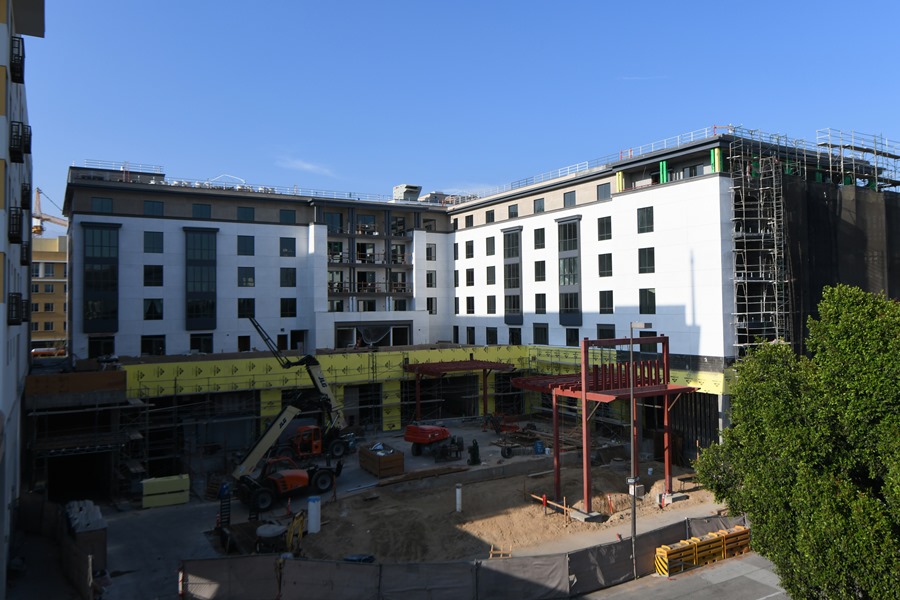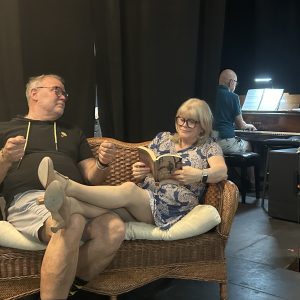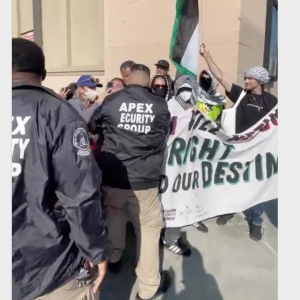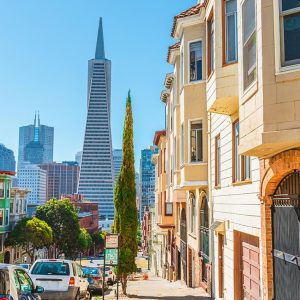 View Winners →
View Winners → Pasadena: City of Choice or City by Default?


Construction in Pasadena is in rapid-clip mode these past few years. This new development on the corner of Sierra Madre Villa and Foothill Boulevard, ironically the busy and noisy construction site dwarfs… A Noise Within Theatre company and a new apartment building east of the new construction. Many of the new developments also obscure views of the San Gabriel Mountains. – Photo by Terry Miller
By Marsha V. Rood, FAICP
I served as the Pasadena City’s Development Administrator in the Housing and Development Department from 1982 – 2000. My job was to know where the City was headed and to make the engine perform to get it there. My primary role was to revitalize what was then a very dilapidated Downtown Pasadena, including Old Pasadena. In that role, I pioneered for Pasadena the economic development strategy of place-based economics instead of a project-by-project development approach. Based upon creating a valuable place, Downtown Pasadena has become a national and international model of how to revitalize a dying Main Street. It is within this context that I am offering my remarks.
Winston Churchill famously said, “We shape our buildings, and afterwards our buildings shape us.” That is why it is so important to get the General Plan right. The “General Plan” is literally the “People’s Plan” – it is essentially the “operating manual” from the people to their elected representatives. The question is: Do we want a City of Choice or a City by Default? More growth is called for in the proposed General Plan, particularly in the Central District – we need to get it right if it is to go forward and be successful. As Jeff Speck writes in “Walkable City: How Downtown Can Save America One Step At a Time,” “… more Americans are desirous of vibrant urban living than are being offered that choice, and those cities that can satisfy that unmet demand will thrive.”
- Consider a moratorium on all new development until we can get it right.
Growth for the sake of growth is the ideology of the cancer cell. Artful, harmonious new construction that resonates with our long tradition of a high quality, beautiful city should be the most important goal of the General Plan. A General Plan that promotes growth without appropriate guidelines and safeguards will compromise the future of Pasadena’s unique sense of place. As growth has occurred in Downtown Pasadena over the past fifteen years, many citizens have questioned “over development” and the associated (a) increase in density; (b) traffic congestion; (c) loss of open space and views; (d) loss of “small‐town” character; (e) declining air quality, and (f) more and louder urban noise. Others have cited the lack of (a) compatible building design with the adjacent built environment; (b) quality construction; (c) public spaces, and (d) a Pasadena expression of design. Of particular offense are the “mono use”, large apartment complexes that seem to be popping up everywhere. More and more citizens are opposing development because they perceive change as a “trading down” of the environment in which they have invested and have come to know and love. In other words, people do not want their investment diminished by the next project – they have a stake in stasis. Well-known urban ecologist Garrett Hardin called this the “tragedy of the commons” – each person maximizes his/her own individual gain at the expense of the “commons” or place. Having unregulated or ineffective land use regulations diminishes the value of the whole place over time.
City staff promotes developers’ interests time and time again: Who is advocating and promoting the City’s greater interest? Existing city plans and rules encourage quality development in accordance with the General Plan, but City Hall too often accommodates developer projects that do not carry out the intent of the General Plan nor the specific rules, regulations and design guidelines that create and promote a quality urban environment. Speaking of development in Pasadena, newly elected Mayor Terry Tornek said at a recent West Pasadena Residents Association meeting: “City Hall staff often ‘pre-digests’ information about city projects and programs, giving elected officials and the public only the conclusions reached by the staff. I would rather let people know what the alternatives are and then make a decision in public. I think that there is some retraining that has to happen at City Hall.”
The “Green Eye Shade Guys” on the staff have taken over the role of planning and community development. They are focusing on fees and economic gain to the City instead of appropriate uses, compatible architecture and urban design that fits Pasadena’s built environment. Essentially, they know the price of everything and the value of nothing. Also, many times certain developers’ attorneys threaten Commissioners with legal action related to “conflict of interest” if they oppose a particular project, thereby eliminating a possible negative vote. To get it right, that is, to follow adopted plans, rules and regulations, citizens have had to use their own money to pay for attorneys, sue the City, appeal decisions of the Design and Planning Commissions to the City Council, organize in groups around specific projects, meet with public officials, spend long hours analyzing staff reports and writing letters to various advisory bodies and the City Council, review project drawings at City Hall because they are not available online, prepare and give public presentations to Design and Planning Commission meetings, and so forth. Citizens are increasingly demanding a seat at the table and are building their political power, legal acumen, and sophisticated methods of protest. As a direct result, city building in Pasadena is becoming more the result of bargained agreements among opposers than of a compelling shared vision for the future.
- More growth: to cap or not to cap?
Development “caps” which limit square footage of commercial uses and the number of housing units divert attention from the heart of the matter, and provide a false sense of security with respect to defending Pasadena’s way of life and specialness. “Caps” do not ensure design standards of high quality; appropriate mix of uses to create attractive, inviting, and affordable places to live, work and play, or create neighborhoods that are not reliant on cars. Building a livable city is more than a numbers game – VMT, FAR, carbon emissions, number of units, number of square feet, use of water and energy and other performance measures. Density should not be at the expense of losing our sense of place: respect for our historic buildings, local culture, public health, diversity and equity; in other words, what makes Pasadena special.
The process of creating a sustainable, people-oriented compact environment is as much art as science. If we do not hold developers to these principles, goals, and policies, there will be failure, whether or not the city is low-density or high density, or how many residential units and commercial square footage is allowed to be built. The quality of development is critical; quality cannot be achieved simply by limiting quantity.
1. City Hall must recognize the value of place to economic development and on the benefits of inter-departmental team work.
The 20th century was about getting around; the 21st century will be about staying in a place worth staying in. Richard Florida, author of the “Creative Class,” states that the quality of place is of growing importance in the future to keep cities vibrant and to attract talent, including the “creative class.” Florida states: “All communities … have to be unique and authentic to their character. A Sense of Place – a city with a unique identity, firmly grounded in respect for its history, with a clear vision and resolve for continued bold progress.” People, businesses, and land developers do not invest in windows, roofs, doors and floors; they invest in place and realize return based upon what they build. In real estate it is called, “Location, Location, Location.” Essentially, there needs to be a “Department of Placemaking” at City Hall.
Pasadena fights about over-development and height limits, but what they are really fighting over is getting the right use, in the right box, in the right place and in the right amount. If you can do that, you can effectively manage evolutionary growth in Pasadena. The economic development staff pushes for development projects, whether or not they are appropriate to the place of Pasadena, and is concerned about “how much time it takes” to get things done in Pasadena. Speeding up a train going the wrong direction will not get you where you want to go. In the face of high real estate demand, the standards are being lowered to “Make the Project Happen.” This is counter intuitive. It is clear that the rules and regulations are written around the project, rather than the project around the rules. The current staff appears not to understand the fact that in Pasadena, to fight for good urban design, architecture, quality of life and place is economic development.
Although the planning and economic development functions are split, economic development (economic development in the City Manager’s Office, and Planning and Community Development as its own department), both report to one Assistant City Manager. There can be a direct conflict of interest when the persons responsible for recruiting companies and businesses to locate in Pasadena, and encouraging new development to be built in Pasadena, is also responsible for administering the zoning code which regulates these two activities. As a result, there is sometimes a temptation not to interpret and/or apply zoning code requirements with the strictness called for by the plan or by the community’s expectations.
City Staff works much of the time in silos (i.e. in isolation from each other), with the resulting distrust and lack of teamwork to address needs and problems at hand. Complex urban environments need a geographically-based management approach that concentrates not on bureaucratic functions (one form of logic), but rather on how they are orchestrated to make the place of choice (another form of logic). As Charles Montgomery writes in “Happy City: Transforming our Lives Through Urban Design”:”…when choosing how to live or move, most of us are not as free as we think. Our options are strikingly limited, and they are defined by the planners, engineers, politicians, architects, marketers, and land speculators who imprint their own values on the urban landscape.” The people who know most about how these different functions come together are the people who live in a particular geographic area. In short, placemaking is community-driven and collaborative, not top-down and project-focused.
- Reinstitute community participation.
According to the General Plan, community participation is supposed to be “a permanent part of achieving a greater city”; that principle has been honored until fairly recently. Jane Jacobs, a keen observer of urban places, said it all: “Cities have the capability of providing something for everybody, only because, and only when, they are created by everybody.” It should be enough for citizens to participate in the General Plan, the Specific Plans, and Planned Developments and have the staff and the advisory bodies/City Council carry out the intent and letter of the rules and regulations to ensure developer compliance. This has not been the case, however, necessitating close community scrutiny of every project and program proposed for consideration. Recently, decisions have been made top-down, with little community participation at critical stages. The nature of community participation has devolved to: (a) late information on major projects timed to allow the least amount of citizen involvement; (b) the lack of site plans and elevations online, requiring citizens to make special appointments to view the documents at City Hall; (c) elimination of community-based task forces for large projects in key locations (e.g. the Lincoln Property/Parsons infill project, the Paseo Colorado’s most recent redevelopment, and the YWCA/Kimpton Hotel addition to the Civic Center); (d) transferring to the developer the City’s role and responsibility in major projects for robust citizen involvement; in other words, allowing developer-convened private meetings in private places on major projects with no public notice and developer-picked citizen participants; (e) allowing the City and the developer to describe a project in great detail with no time limits, while at the same time limiting citizens to speak only three or four minutes each at City Council, Design and Planning Commissions; (f) closed sessions of the City Council at key decision points on a project when the deliberations should be public; (g) lack of public information/disclosure/availability of key project documents. Unfortunately, these rigid planning processes have become so institutionalized that community stakeholders are rarely consulted and have lost the chance to voice their own ideas and aspirations about the places they inhabit and love.
- Pedestrian and bicycle improvements need to be the focus.
The pedestrian is essentially the canary in the coal mine of urban livability and economic viability – the soft under-belly of walkable urbanism. To achieve the goals of the adopted General Plan, special emphasis must be placed on planning and implementing a complete set of pedestrian and bicycle improvements. The environmental impacts of additional growth, particularly in Downtown Pasadena, can be mitigated only through an improved pedestrian and bicycle network. Although creating a compact environment is critical to sustainable city building, that alone is not enough. The City needs to be a City committed to an implementation plan to create a place where people not only can walk, but also consider it to be their “superior mode choice”. The way we live largely determines the way we move.
Right now the City can create a funding source for pedestrian and bicycle improvements by simply amending Pasadena’s Municipal Code Section 4.19.060 to allow pedestrian and bicycle improvements to be funded from “Traffic Reduction and Transportation Improvement Fees” collected from individual development projects. This fee is intended to mitigate the traffic impacts of new development, including industrial, office, retail and residential uses. Given the large size and number of projects in the development pipeline, this fee will generate millions of available dollars for such improvements. However, according to the City’s Transportation Department, it would be “illegal” to use these traffic impact mitigation funds for pedestrian and bicycle improvements. This Section of the Municipal Code needs to be updated to reflect the City’s adopted General Plan, implementing policies and ordinances, and recommended “Complete Streets.” According to City staff, a “nexus” or connections study would have to be completed in order to establish the fact that if you are walking and biking you are not driving. This issue is critical and needs to be put on the front burner because the fees of any specific development cannot be used for pedestrian and bicycle improvements before the amendment is approved to allow funding for such improvements. This requires political will because City staff is taking an inordinate amount of time to process this amendment. No matter what form of transportation – car, transit, bicycle –we are all pedestrians in the end.
As Albert Einstein once said, “Politics is not about good ideas – good ideas are obvious. Politics is about forming coalitions to take action.”

Construction in Pasadena is in rapid-clip mode these past few years. This new development on the corner of Sierra Madre Villa and Foothill Boulevard, ironically the busy and noisy construction site dwarfs… A Noise Within Theatre company and a new apartment building east of the new construction. Many of the new developments also obscure views of the San Gabriel Mountains. – Photo by Terry Miller












































































































